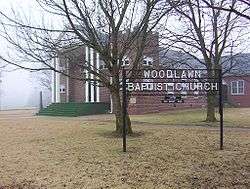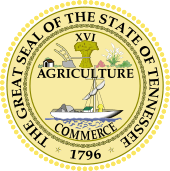Woodlawn Baptist Church and Cemetery
Woodlawn Baptist Church and Cemetery, also known as Woodlawn Missionary Baptist Church, is a historic building in Nutbush, Haywood County, Tennessee, in the United States. It is on Woodlawn Road, south of Tennessee State Route 19.
Woodlawn Baptist Church and Cemetery | |
 | |
  | |
| Location | Woodlawn Rd., S of TN 19 Nutbush, Tennessee |
|---|---|
| Coordinates | 35.653042°N 89.364917°W |
| Built | 1927 |
| Architectural style | gothic & classical revival influence |
| NRHP reference No. | 96001358[1] |
| Added to NRHP | December 2, 1996 |
Founded in 1866 largely by freedmen, Woodlawn Baptist Church and Cemetery was added to the National Register of Historic Places in 1966.[2]
When singer Tina Turner was growing up as Anna Mae Bullock in Nutbush, Woodlawn Baptist was one of her family churches.[3]
History

Most slave congregations were ministered by white pastors. In 1846, the young slave Hardin Smith, born in Virginia, was allowed by his master's wife to preach to a slave congregation at an evening service at the white Woodlawn Church.[4] It was located near Woodlawn Road. He was the first slave to preach to an area congregation.[5]
Hardin Smith was of mixed race; his white father was his mother's master Abner Smith. Hardin, his mother and siblings were sold away from Virginia. In Tennessee, he was secretly taught by his master's wife and children to read and write through the Bible; it was against state law at the time. He in turn secretly taught many slaves to read and write.[6]
In 1866, after emancipation and the end of the Civil War, Hardin Smith and Martin Winfield were among three men in Haywood County selected by missionaries of the Baptist Home Mission Board for the first classes in ministry at the newly established Roger Williams College in Nashville.[6] The Northern Baptists wanted to aid freedmen in the South and plant new churches. After his return to Nutbush, Smith, together with other freedmen, the Freedmen's Bureau, and a few whites, founded the Woodlawn Colored Baptist Church. (It is now known as Woodlawn Missionary Baptist Church.) He was called as the pastor there and served for the next 56 years, to the end of his life.[4]
He consistently encouraged education among his congregation. In 1866 Smith and Winfield helped establish the Freedman School in the county seat of Brownsville.[4] It later developed into twelve grades.
Smith was a community leader, organizing five other black Baptist churches in Haywood and nearby Lauderdale counties.[4] Winfield helped found the First Baptist Church in Brownsville and became its pastor.[5] All emphasized education.
These black Baptist churches soon withdrew from white supervision, as did most black Baptists in the South, establishing their own churches and associations.[7][8] Smith participated in organizing the National Negro Baptist Convention, which in 1895 merged with two other groups as the National Baptist Convention USA, Inc.. This formed the largest black Baptist convention in the United States.
Smith also participated in founding Howe Institute of Technology (now merged into LeMoyne-Owen College), an historically black college in Memphis; and developing Roger Williams College from its beginnings in 1866. Before 1900, more students went to Roger Williams College from the Woodlawn Missionary Baptist Church than from any other community in Tennessee.[4] Graduates from Roger Williams helped lead other black schools and colleges; they became ministers, doctors, lawyers, and teachers.[4][5]
In 1996, Woodlawn Baptist Church and Cemetery was added to the National Register of Historic Places for its historical significance.[2]
Tina Turner Highway
Woodlawn Baptist Church is located 3 mi (4.8 km) southeast of Nutbush, south of Tennessee State Route 19. A stretch of State Route 19 between Brownsville and Nutbush was named "Tina Turner Highway" in 2002 after singer Tina Turner (born Anna Mae Bullock), who was born and lived as a child in Nutbush.[9][10][11]
Woodlawn Baptist Church in Nutbush was a family church of Tina Turner. She attended and sang in the choir growing up. Her family members were church officials, musicians and singers; some are buried in this cemetery.[3]
References
| Wikimedia Commons has media related to Woodlawn Baptist Church and Cemetery. |
- "National Register Information System". National Register of Historic Places. National Park Service. March 13, 2009.
- National Register of Historic Places
- Information by Sharon Norris, national preservationist, author and researcher of Black America Series: Haywood County Tennessee.
- "Hardin Smith," The Tennessee Encyclopedia of History and Culture, Rutledge Press
- Norris, Sharon, Black America Series: Haywood County, Tennessee, Arcadia Publishing, 2000
- Norris (2000), Black America Series: Haywood County, Tennessee, Arcadia Publishing, p. 8
- Brooks, Walter H. "The Evolution of the Negro Baptist Church." Journal of Negro History (1922) 7#1 pp: 11-22. in JSTOR
- Albert J. Raboteau, Slave Religion: The "invisible Institution" in the Antebellum South (1979)
- Wilder, John S. (January 17, 2002). "SB 2798: Highway Signs – "Tina Turner Highway"" (PDF). Legislation Archives – Bills and Resolutions: 102nd General Assembly. Nashville, TN: Tennessee Senate. Retrieved June 26, 2010.
- Fitzhugh, Craig (January 22, 2002). "HB 2535: Highway Signs – "Tina Turner Highway"" (PDF). Legislation Archives – Bills and Resolutions: 102nd General Assembly. Nashville, TN: Tennessee House of Representatives. Retrieved June 26, 2010.
- Associated Press (September 25, 2002). "Highway to Be Named for Tina Turner". AP Online News Wire. Archived from the original on November 4, 2012. Retrieved June 26, 2010.
Further reading
- Norris, Sharon (2000). Black America Series: Haywood County Tennessee. Mount Pleasant, SC: Arcadia Publishing. ISBN 0-7385-0605-2.
